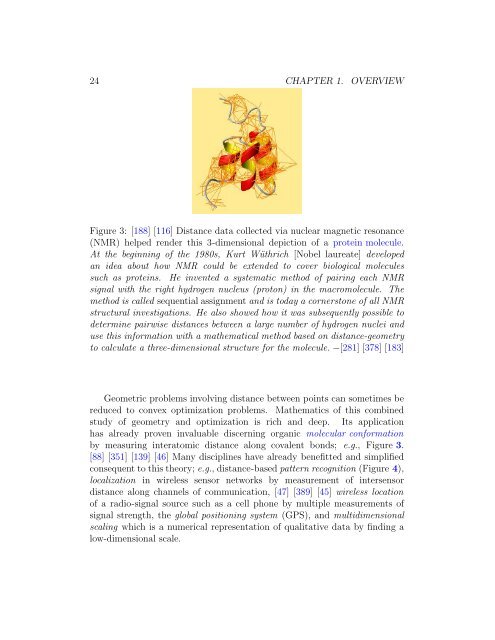v2010.10.26 - Convex Optimization
v2010.10.26 - Convex Optimization v2010.10.26 - Convex Optimization
24 CHAPTER 1. OVERVIEWFigure 3: [188] [116] Distance data collected via nuclear magnetic resonance(NMR) helped render this 3-dimensional depiction of a protein molecule.At the beginning of the 1980s, Kurt Wüthrich [Nobel laureate] developedan idea about how NMR could be extended to cover biological moleculessuch as proteins. He invented a systematic method of pairing each NMRsignal with the right hydrogen nucleus (proton) in the macromolecule. Themethod is called sequential assignment and is today a cornerstone of all NMRstructural investigations. He also showed how it was subsequently possible todetermine pairwise distances between a large number of hydrogen nuclei anduse this information with a mathematical method based on distance-geometryto calculate a three-dimensional structure for the molecule. −[281] [378] [183]Geometric problems involving distance between points can sometimes bereduced to convex optimization problems. Mathematics of this combinedstudy of geometry and optimization is rich and deep. Its applicationhas already proven invaluable discerning organic molecular conformationby measuring interatomic distance along covalent bonds; e.g., Figure 3.[88] [351] [139] [46] Many disciplines have already benefitted and simplifiedconsequent to this theory; e.g., distance-based pattern recognition (Figure 4),localization in wireless sensor networks by measurement of intersensordistance along channels of communication, [47] [389] [45] wireless locationof a radio-signal source such as a cell phone by multiple measurements ofsignal strength, the global positioning system (GPS), and multidimensionalscaling which is a numerical representation of qualitative data by finding alow-dimensional scale.
25Figure 4: This coarsely discretized triangulated algorithmically flattenedhuman face (made by Kimmel & the Bronsteins [226]) represents a stagein machine recognition of human identity; called face recognition. Distancegeometry is applied to determine discriminating-features.Euclidean distance geometry together with convex optimization have alsofound application in artificial intelligence:to machine learning by discerning naturally occurring manifolds in:– Euclidean bodies (Figure 5,6.7.0.0.1),– Fourier spectra of kindred utterances [212],– and photographic image sequences [372],to robotics; e.g., automatic control of vehicles maneuvering information. (Figure 8)by chapterWe study pervasive convex Euclidean bodies; their many manifestationsand representations. In particular, we make convex polyhedra, cones, anddual cones visceral through illustration in chapter 2 Convex geometrywhere geometric relation of polyhedral cones to nonorthogonal bases
- Page 1 and 2: DATTORROCONVEXOPTIMIZATION&EUCLIDEA
- Page 3 and 4: Convex Optimization&Euclidean Dista
- Page 5 and 6: for Jennie Columba♦Antonio♦♦&
- Page 7 and 8: PreludeThe constant demands of my d
- Page 9 and 10: Convex Optimization&Euclidean Dista
- Page 11 and 12: CONVEX OPTIMIZATION & EUCLIDEAN DIS
- Page 13 and 14: List of Figures1 Overview 211 Orion
- Page 15 and 16: LIST OF FIGURES 1562 Shrouded polyh
- Page 17: LIST OF FIGURES 17130 Elliptope E 3
- Page 21 and 22: Chapter 1OverviewConvex Optimizatio
- Page 23: ˇx 4ˇx 3ˇx 2Figure 2: Applicatio
- Page 27 and 28: (biorthogonal expansion) is examine
- Page 29 and 30: 29cardinality Boolean solution to a
- Page 31 and 32: 31Figure 8: Robotic vehicles in con
- Page 33 and 34: an elaborate exposition offering in
- Page 35 and 36: Chapter 2Convex geometryConvexity h
- Page 37 and 38: 2.1. CONVEX SET 372.1.2 linear inde
- Page 39 and 40: 2.1. CONVEX SET 392.1.6 empty set v
- Page 41 and 42: 2.1. CONVEX SET 41(a)R(b)R 2(c)R 3F
- Page 43 and 44: 2.1. CONVEX SET 43where Q∈ R 3×3
- Page 45 and 46: 2.1. CONVEX SET 45Now let’s move
- Page 47 and 48: 2.1. CONVEX SET 47By additive inver
- Page 49 and 50: 2.1. CONVEX SET 49R nR mR(A T )x px
- Page 51 and 52: 2.2. VECTORIZED-MATRIX INNER PRODUC
- Page 53 and 54: 2.2. VECTORIZED-MATRIX INNER PRODUC
- Page 55 and 56: 2.2. VECTORIZED-MATRIX INNER PRODUC
- Page 57 and 58: 2.2. VECTORIZED-MATRIX INNER PRODUC
- Page 59 and 60: 2.2. VECTORIZED-MATRIX INNER PRODUC
- Page 61 and 62: 2.3. HULLS 61Figure 20: Convex hull
- Page 63 and 64: 2.3. HULLS 63Aaffine hull (drawn tr
- Page 65 and 66: 2.3. HULLS 65subset of the affine h
- Page 67 and 68: 2.3. HULLS 672.3.2.0.2 Example. Nuc
- Page 69 and 70: 2.3. HULLS 692.3.2.0.3 Exercise. Co
- Page 71 and 72: 2.3. HULLS 71Figure 24: A simplicia
- Page 73 and 74: 2.4. HALFSPACE, HYPERPLANE 73H + =
24 CHAPTER 1. OVERVIEWFigure 3: [188] [116] Distance data collected via nuclear magnetic resonance(NMR) helped render this 3-dimensional depiction of a protein molecule.At the beginning of the 1980s, Kurt Wüthrich [Nobel laureate] developedan idea about how NMR could be extended to cover biological moleculessuch as proteins. He invented a systematic method of pairing each NMRsignal with the right hydrogen nucleus (proton) in the macromolecule. Themethod is called sequential assignment and is today a cornerstone of all NMRstructural investigations. He also showed how it was subsequently possible todetermine pairwise distances between a large number of hydrogen nuclei anduse this information with a mathematical method based on distance-geometryto calculate a three-dimensional structure for the molecule. −[281] [378] [183]Geometric problems involving distance between points can sometimes bereduced to convex optimization problems. Mathematics of this combinedstudy of geometry and optimization is rich and deep. Its applicationhas already proven invaluable discerning organic molecular conformationby measuring interatomic distance along covalent bonds; e.g., Figure 3.[88] [351] [139] [46] Many disciplines have already benefitted and simplifiedconsequent to this theory; e.g., distance-based pattern recognition (Figure 4),localization in wireless sensor networks by measurement of intersensordistance along channels of communication, [47] [389] [45] wireless locationof a radio-signal source such as a cell phone by multiple measurements ofsignal strength, the global positioning system (GPS), and multidimensionalscaling which is a numerical representation of qualitative data by finding alow-dimensional scale.



